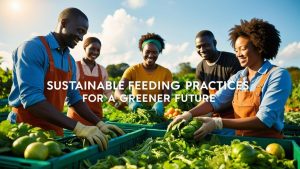Sustainable feeding practices play a crucial role in promoting environmental conservation, improving animal health, and ensuring global food security. As the demand for animal-based products increases, it is essential to adopt feeding strategies that minimize waste, reduce carbon footprints, and optimize resource use.
This article explores various sustainable feeding practices that contribute to a greener future in livestock and poultry farming.
Click HERE to join our WhatsApp group chat
Importance of Sustainable Feeding Practices
a) Reducing Environmental Impact
Conventional animal feed production contributes to deforestation, water depletion, and greenhouse gas emissions.
Sustainable feed practices help lower methane emissions, minimize land use, and prevent excessive resource exploitation.
b) Enhancing Animal Health and Productivity
Balanced, nutrient-dense diets improve growth rates, reduce disease susceptibility, and enhance reproductive efficiency.
Avoiding harmful additives ensures healthier livestock and safer food products for consumers.
c) Addressing Global Food Security
Efficient feed utilization reduces competition between human food and animal feed resources.
Alternative feed sources lessen dependence on conventional grains and promote food system resilience.
READ ALSO: Waste Management in Livestock and Poultry Farming
Alternative and Sustainable Feed Ingredients

a) Insect-Based Protein Sources
Black soldier fly larvae, mealworms, and crickets offer high-protein, low-impact feed alternatives.
Insect farming requires minimal land and water resources, making it an environmentally friendly option.
b) Algae and Seaweed as Feed Supplements
Rich in essential fatty acids, proteins, and minerals, algae and seaweed enhance animal nutrition.
They contribute to methane reduction in ruminants and improve gut health in poultry.
c) Fermented and Probiotic-Enriched Feeds
Fermentation enhances nutrient bioavailability and improves digestive health in animals.
Probiotic-enriched feeds support gut microbiota, reducing reliance on antibiotics.
READ ALSO: Alternative Feed Resources for Cost Reduction
d) Food Waste and Byproducts in Animal Diets
Utilizing agricultural byproducts (e.g., rice bran, brewers’ grains, fruit peels) reduces food waste and feed costs.
Proper processing ensures safety and maintains nutritional value.
Sustainable Feed Production Methods
a) Precision Feeding Techniques
Automated feeding systems deliver precise amounts of feed, minimizing waste and optimizing intake.
Real-time monitoring of feed consumption enhances efficiency and reduces overfeeding.
b) Hydroponic and Sprouted Feeds
Hydroponic fodder systems produce fresh, high-nutrient forage using less water and land.
Sprouted grains improve digestibility and reduce dependency on commercial feed sources.
c) Circular Farming Systems
Integrating livestock and crop production promotes nutrient cycling and waste reduction.
Manure management and composting improve soil health while reducing environmental pollution.
Reducing the Carbon Footprint of Livestock Diets
a) Low-Carbon Feed Ingredients
Shifting towards regionally available feed ingredients reduces transportation emissions.
Carbon footprint labeling in feed production supports informed decision-making by farmers.
b) Grass-Fed and Pasture-Based Systems
Rotational grazing enhances soil carbon sequestration and reduces reliance on grain-based diets.
Well-managed pasture systems support biodiversity and ecosystem health.
READ ALSO: Nutritional Requirements for Quails
c) Methane-Reducing Feed Additives
Incorporating tannins, essential oils, and seaweed extracts helps lower enteric methane emissions in ruminants.
Research on feed additives continues to improve sustainability without compromising productivity.
Economic and Social Benefits of Sustainable Feeding
a) Cost Savings for Farmers
Alternative feed ingredients and precision feeding lower feed expenses.
Reducing dependency on imported feed ingredients ensures price stability.
b) Consumer Demand for Sustainable Products
Ethical consumerism is driving demand for sustainably raised livestock and poultry.
Certification programs (e.g., organic, regenerative agriculture) create market incentives for sustainable feeding.
c) Policy and Government Support
Governments are encouraging sustainable agriculture through incentives, grants, and regulations.
International guidelines promote responsible feed sourcing and environmental conservation.
Conclusion
Sustainable feeding practices are essential for mitigating climate change, conserving natural resources, and ensuring long-term food security. By incorporating alternative feed ingredients, optimizing feed efficiency, and reducing carbon footprints, farmers can contribute to a greener future while maintaining profitability. Adopting sustainable livestock nutrition strategies benefits both the environment and global food systems, paving the way for a more resilient and responsible agricultural industry.
READ ALSO: Antimicrobial Resistance in Animal Health
Antimicrobial resistance (AMR) is one of the most pressing global health concerns affecting both human and animal populations. In animal health, the widespread use of antibiotics and other antimicrobial agents in livestock and poultry has contributed to the emergence and spread of resistant pathogens. This issue poses serious threats to food security, public health, and the effectiveness of disease treatment in animals. Understanding…
READ ALSO: Alternative Feed Resources for Cost Reduction
The rising cost of conventional animal feed has become a significant challenge for livestock and poultry farmers worldwide. Feed expenses account for a substantial portion of total production costs, making it essential to explore alternative feed resources to maintain profitability and sustainability. Alternative feeds, derived from agricultural by-products, unconventional plants, and food industry waste, offer cost-effective and nutritionally viable options for livestock and poultry…
Click HERE to join our WhatsApp group chat